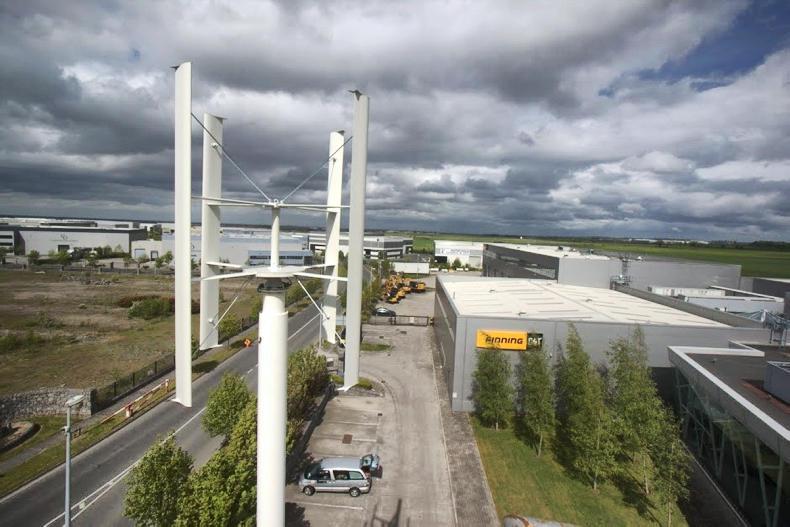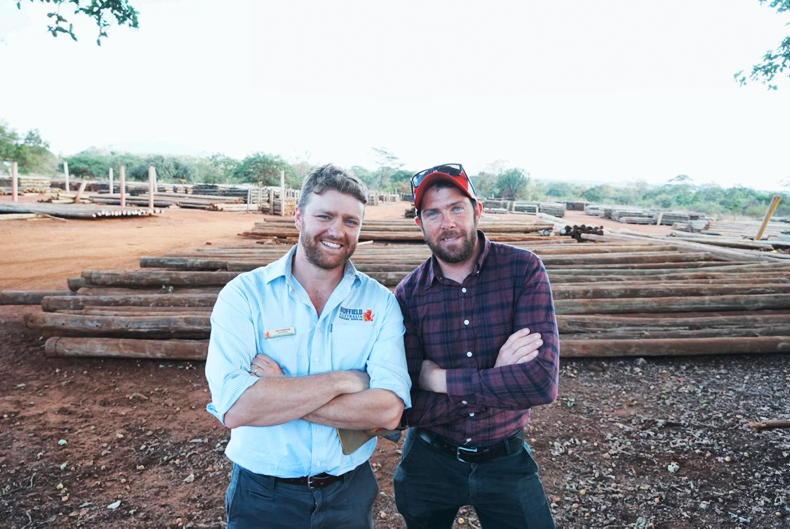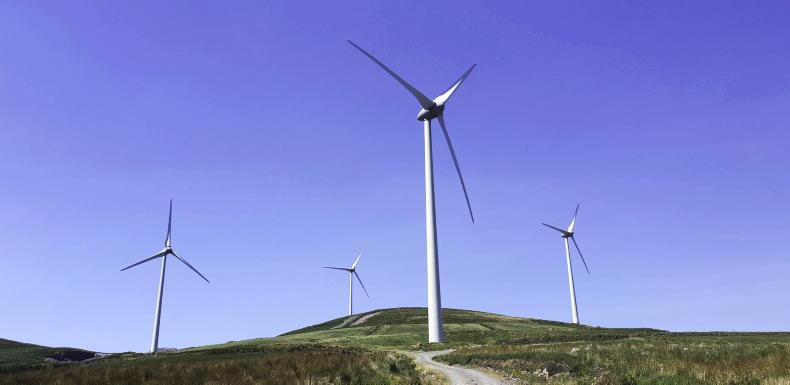Wind turbines transforms kinetic energy from the wind into electric power. Horizontal-axis wind turbines have been a common sight across the Irish landscape for decades. Horizontal axis wind turbines (HAWT) are defined as having the rotating axis of the turbine ie its generator, horizontal, or parallel with the ground.
In areas of big wind application, such as commercial wind farms, this will most likely be the only type of wind turbine that you will find. However, there is another, less common design of wind turbine, which has its own place in Ireland’s renewable industry.
Vertical axis wind turbines (VAWT) is a design of wind turbine, where its rotational axis turbine stands vertical or perpendicular to the ground.
This design allows for the gearbox and generator to be located close to the ground which can facilitate easier service and repair.
Why horizontal dominates
Each system has its advantages and disadvantages. HAWTs have been around for generations now and, as a result, their design has been perfected to allow for maximum efficiently. For example, HAWTs are fitted with variable blade pitch mechanisms, which adjust the turbine blades to allow for the optimum angle of attack. This allows the turbine to collect the maximum amount of wind energy.
But the design also has a number of disadvantages. For example, the majority of HAWTs use an upwind design, where the rotor faces the wind in front of the tower.
Downwind designs can suffer from fatigue. This can even lead to structural failure caused by turbulence when a blade passes through the tower’s wind shadow.
Advantages and disadvantages of vertical

From left: Savnoius VAWT, Modern HAWT and a Giromill VAWT.
There are generally three different designs of vertical axis wind turbines (VAWTs), Giromill, Savnoius and the Darrieus. The Giromill is the most common design of VAWT and uses two to three straight blades individually attached to a vertical axis.
Wind speed
VAWTs generally do not need as much wind to produce power and are commonly built nearer to the ground. This has a range of benefits including improved accessibility, lower construction costs and logistics. Winds nearer ground level, however, have less power and, for a similar wind capture area, a lower amount of power is generated.
With that said, however, there is the potential to pack vertical axis turbines closer together in a wind farm than conventional horizontal axis turbines. There is even the suggestion that VAWTs could be installed on existing HAWT wind farms, between the existing turbines, supplementing the power output of the farm.
Wind direction
Another key advantage of a VAWT over the HAWT is that it does not need a yaw mechanism. A HAWT yaw mechanism is used to turn the turbine rotor against the wind, allowing it to harness the wind from a range of directions.
Depending on the design, VAWTs are omni-directional and do not need to track the wind.
This allows the turbine to harness the wind from all directions without the need for a yaw mechanism.
VAWTs generally function better than HAWTs in areas of variable wind speed. HAWTs cannot efficiently harvest those kinds of wind which may also cause accelerated structural fatigue.
Noise
VAWTs are also quieter to operate than their horizontal counterparts. A 2014 study found that dB levels at ground level, 10m from a HAWT measured about 95dB.
This is about the sound of a main road with cars passing by.
In the same test parameters, the dB levels measured about 38dB for a VAWT of the same output, which is about the sound of whispered conversation.
Variability in wind speed
VAWTs operate on low wind speeds and work on a low starting torque. In gusty conditions, they can potentially have dynamic stability issues.
This can limit VAWTs to environments with a low wind speed
Durability
The blades, which are attached to VAWTs, are exposed to a wide range of applied forces with every rotation which can leave the blades vulnerable to fatigue.
Cost
In general, VAWTs are less expensive than HAWTs for a range of reasons including less materials, lower turbine erection costs and less moving parts.
Vertical applications
VAWTs are primarily used in small wind projects and residential applications.
As mentioned previously, a key strength of VAWTs is its ability to be powered by wind coming from 360 degrees.
Because of this versatility, and the fact that they suit lower heights, VAWTs can suit residential and commercial settings where conventional horizontal axis wind turbines cannot be erected.
Read more
‘Brussels will no longer prescribe the width of a hedge’ – Hogan
Energy savings top of the agenda for poultry event
Wind turbines transforms kinetic energy from the wind into electric power. Horizontal-axis wind turbines have been a common sight across the Irish landscape for decades. Horizontal axis wind turbines (HAWT) are defined as having the rotating axis of the turbine ie its generator, horizontal, or parallel with the ground.
In areas of big wind application, such as commercial wind farms, this will most likely be the only type of wind turbine that you will find. However, there is another, less common design of wind turbine, which has its own place in Ireland’s renewable industry.
Vertical axis wind turbines (VAWT) is a design of wind turbine, where its rotational axis turbine stands vertical or perpendicular to the ground.
This design allows for the gearbox and generator to be located close to the ground which can facilitate easier service and repair.
Why horizontal dominates
Each system has its advantages and disadvantages. HAWTs have been around for generations now and, as a result, their design has been perfected to allow for maximum efficiently. For example, HAWTs are fitted with variable blade pitch mechanisms, which adjust the turbine blades to allow for the optimum angle of attack. This allows the turbine to collect the maximum amount of wind energy.
But the design also has a number of disadvantages. For example, the majority of HAWTs use an upwind design, where the rotor faces the wind in front of the tower.
Downwind designs can suffer from fatigue. This can even lead to structural failure caused by turbulence when a blade passes through the tower’s wind shadow.
Advantages and disadvantages of vertical

From left: Savnoius VAWT, Modern HAWT and a Giromill VAWT.
There are generally three different designs of vertical axis wind turbines (VAWTs), Giromill, Savnoius and the Darrieus. The Giromill is the most common design of VAWT and uses two to three straight blades individually attached to a vertical axis.
Wind speed
VAWTs generally do not need as much wind to produce power and are commonly built nearer to the ground. This has a range of benefits including improved accessibility, lower construction costs and logistics. Winds nearer ground level, however, have less power and, for a similar wind capture area, a lower amount of power is generated.
With that said, however, there is the potential to pack vertical axis turbines closer together in a wind farm than conventional horizontal axis turbines. There is even the suggestion that VAWTs could be installed on existing HAWT wind farms, between the existing turbines, supplementing the power output of the farm.
Wind direction
Another key advantage of a VAWT over the HAWT is that it does not need a yaw mechanism. A HAWT yaw mechanism is used to turn the turbine rotor against the wind, allowing it to harness the wind from a range of directions.
Depending on the design, VAWTs are omni-directional and do not need to track the wind.
This allows the turbine to harness the wind from all directions without the need for a yaw mechanism.
VAWTs generally function better than HAWTs in areas of variable wind speed. HAWTs cannot efficiently harvest those kinds of wind which may also cause accelerated structural fatigue.
Noise
VAWTs are also quieter to operate than their horizontal counterparts. A 2014 study found that dB levels at ground level, 10m from a HAWT measured about 95dB.
This is about the sound of a main road with cars passing by.
In the same test parameters, the dB levels measured about 38dB for a VAWT of the same output, which is about the sound of whispered conversation.
Variability in wind speed
VAWTs operate on low wind speeds and work on a low starting torque. In gusty conditions, they can potentially have dynamic stability issues.
This can limit VAWTs to environments with a low wind speed
Durability
The blades, which are attached to VAWTs, are exposed to a wide range of applied forces with every rotation which can leave the blades vulnerable to fatigue.
Cost
In general, VAWTs are less expensive than HAWTs for a range of reasons including less materials, lower turbine erection costs and less moving parts.
Vertical applications
VAWTs are primarily used in small wind projects and residential applications.
As mentioned previously, a key strength of VAWTs is its ability to be powered by wind coming from 360 degrees.
Because of this versatility, and the fact that they suit lower heights, VAWTs can suit residential and commercial settings where conventional horizontal axis wind turbines cannot be erected.
Read more
‘Brussels will no longer prescribe the width of a hedge’ – Hogan
Energy savings top of the agenda for poultry event











SHARING OPTIONS